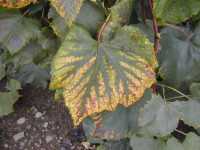Managing Magnesium In Grapes

One of the important characteristics of soil when it comes to supplying nutrients is its “cation exchange capacity,” or its ability to supply the nutrients that come in cation form (cation = ion with a positive electrical charge). In the realm of plant nutrition, the cations we usually talk about are potassium, magnesium, and calcium (K, Mg, Ca). Of the three, magnesium is required in the smallest amount in the vine, but that small amount serves some very important functions.
Like most of the other essential nutrients, magnesium has a few different roles in the plant. One of the primary ones is as the central atom in the chlorophyll molecule, which explains why leaves in deficient vines have leaves that are chlorotic, or yellowing, between the veins of older leaves. Magnesium is also important in the formation and functioning of ATP, the plant’s cellular energy source, the synthesis of DNA and RNA, and many other enzymatic reactions.
How Much Does The Plant Need?
While categorized as a macronutrient, along with nitrogen, potassium, calcium, sulfur, and phosphorous, vines do not require as much magnesium as the others in this group.
The generally accepted standard for magnesium in petiole samples is about 0.3% to 0.5% at bloom, and 0.35% to 0.75% in samples taken 70 to 100 days after bloom. Because the vine does not require as much magnesium as other nutrients, it also does not lose as much when the fruit is harvested — about 0.2 pounds per ton of grapes harvested.
Magnesium is taken up by the vines in its ionic form, Mg2+, like other cation nutrients. Because its valence, or charge, is similar to that of other cations, primarily potassium (K+) and calcium (Ca2+), it competes with these other nutrients for uptake by the vines’ roots. In other words, if there is an excess of any of these three nutrients in the soil, it can induce a deficiency of one or both of the others.
We usually see this antagonism played out between potassium and magnesium. For example, dolomitic limestone (limestone with both magnesium and calcium carbonates) is often applied in vineyards with acidic soils to maintain or raise soil pH because magnesium is less accessible to the roots at lower pH. However, if large amounts of lime are applied at once, it is possible to create a potassium deficiency later on because of the presence of so much magnesium relative to the potassium content of the soils.
Magnesium deficiency symptoms generally show up in late summer and fall, when the tissue between the primary veins on basal leaves will start to turn yellow, while the tissue near the veins remains green. In red-fruited varieties, the leaves may turn a reddish color more than yellow. The deficiency will first appear on basal leaves because the vines will mobilize nutrients like magnesium from older leaves to younger ones when they are in short supply.
Correcting Mg Deficiencies
Magnesium sulfate (MgSO4), also sold as Epsom salt, is usually used to address magnesium deficiencies, especially if soil pH does not need to be adjusted. It can be applied either as a foliar spray or to the soil. Foliar applications can be used to correct small deficiencies in a single season, but soil applications are more appropriate for longer-term correction. Foliar applications should be made two to three times around fruit set, using a rate of 5 to 10 pounds of MgSO4 in 75 to 100 gallons of water per acre.
If soil pH needs to be raised, dolomitic limestone can be used to increase pH and add magnesium to the soil simultaneously at a rate of 1 to 2 tons per acre. Adding higher amounts may trigger the potassium deficiencies mentioned earlier. If using magnesium sulfate, we usually recommend applying 300 to 600 pounds per acre as a band under the trellis.









